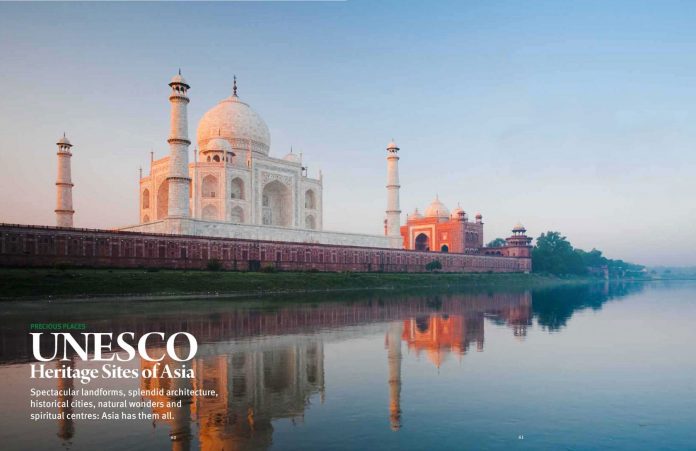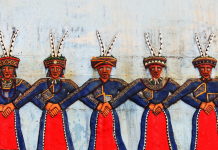Spectacular landforms, splendid architecture, historical cities, natural wonders and spiritual centres: Asia has them all. Asian Geographic looks at the spectacular UNESCO Heritage Sites across the entire Asian continent.
India
Taj Mahal
Location: Uttar Pradesh, Agra
Date of Inscription: 1983
The Taj Mahal is located on the right bank of the Yamuna River, in a vast Mughal garden that encompasses nearly 17 hectares in Agra, Uttar Pradesh. It was built by Mughal Emperor Shah Jahan in memory of his wife Mumtaz Mahal. Its construction began in 1632 AD and was completed in 1648 AD. The mosque, the guest house and the main gateway on the south, the outer courtyard and its cloisters were added subsequently and completed in 1653 AD. For its construction, masons, stone-cutters, inlayers, carvers, painters, calligraphers, dome builders and other artisans were requisitioned from the whole of the empire and also from the Central Asia and Iran. Ustad-Ahmad Lahori was the main architect of the Taj Mahal. The existence of several historical and Quranic inscriptions in Arabic script have facilitated the understanding of the arrangement of events in the history of Taj Mahal.
Cambodia
Angkor
Location: Siem Reap
Date of Inscription: 1992

Angkor is one of the most important archaeological sites in Southeast Asia. Stretching over some 400km2 including forested area, Angkor Archaeological Park contains the magnificent remains of the different capitals of the Khmer Empire from the 9th to the 15th century. They include the famous Temple of Angkor Wat, Angkor Thom, the Bayon, Preah Khan and Ta Prohm all of which have countless sculptural decorations. UNESCO has set up a wide-ranging programme to safeguard this symbolic site and
its surroundings.
 Philippines
Philippines
Historic City of Vigan
Location: Ilocos Sur, Luzon
Date of Inscription: 1999
Vigan is the most intact example in Asia of a planned Spanish colonial town, established in the 16th century. Its architecture reflects the coming together of cultural elements from elsewhere in the Philippines and from China with those of Europe and Mexico to create a unique culture and townscape without parallels anywhere in East and Southeast Asia. An important trading post before the colonial era, Vigan is located at the river delta of Abra River, along the northwestern coastline of the main island of Luzon. The total area of the inscribed property is 17.25 hectares. The traditional Hispanic checkerboard street plan opens up into two adjacent plazas. The Plaza Salcedo is the longer arm of an L-shaped open space, with the Plaza Burgos as the shorter. The two plazas are dominated by St. Paul’s Cathedral, the Archbishop’s Palace, the City Hall and the Provincial Capitol Building. The urban plan of the town closely conforms with the Renaissance grid plan specified in the Laws of the Indies (Leyas de las Indias) for all new towns in the Spanish Empire.
Malaysia
Melaka & George Town, Historic Cities of the Straits of Malacca
Location: Melacca and Penang
Date of Inscription: 2008

Melaka and George Town have developed over 500 years of trading and cultural exchanges between East and West in the Straits of Malacca. The influences of Asia and Europe have endowed the towns with a specific multicultural heritage that is both tangible and intangible. With its government buildings, churches, squares and fortifications, Malacca demonstrates the early stages of this history originating in the 15th-century Malay sultanate and the Portuguese and Dutch periods beginning in the early 16th century.
 Featuring residential and commercial buildings, George Town represents the British era from the end of the 18th century. The two towns constitute a unique architectural and cultural townscape without parallel anywhere in East and Southeast Asia.
Featuring residential and commercial buildings, George Town represents the British era from the end of the 18th century. The two towns constitute a unique architectural and cultural townscape without parallel anywhere in East and Southeast Asia.
To read the rest of this article, check out our latest issue of Asian Geographic No.136 Issue 3/2019 here or download a digital copy here




![The Road to Independence: Malaya’s Battle Against Communism [1948-1960]](https://asiangeo.com/wp-content/uploads/2021/07/WhatsApp-Image-2021-07-26-at-11.07.56-AM-218x150.jpeg)






